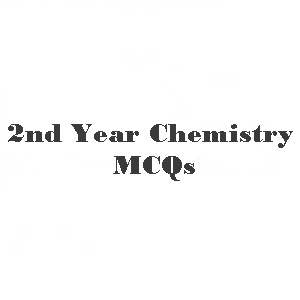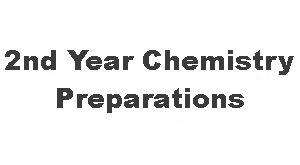This page is about 2nd Year Chemistry Hydrocarbons MCQs and you can get Hydrocarbons MCQs with answers here. The organic compounds which having Carbon and Hydrogen are Hydrocarbons. They are classified into Straight chain or Acyclic hydrocarbons and Closed chain or Cyclic hydrocarbons. Straight chain hydrocarbons consist of Saturated and unsaturated hydrocarbons. They have specific nomenclature. Alkanes, Alkenes, and Alkynes are different hydrocarbons. Alkanes are the hydrocarbons having a single bond. Alkenes and Alkynes consist of double and Triple bonds respectively. There are various methods to prepare them. They have unique properties, uses, and reactions. Aromatic Hydrocarbons are those containing a benzene ring. Benzene has a special structure. Benzene is prepared in different ways. It reacts with different elements. Benzene undergoes a substitution reaction. So, this is a brief introduction to this chapter. Check the important MCQs of Aliphatic and Aromatic Hydrocarbons given below.
2nd Year Chemistry Hydrocarbons MCQs

KEY POINTS
- Nomenclature of Alkanes, Alkenes, and Alkynes
- Preparation of Alkanes, Alkenes, and Alkynes
- Reactions and uses
- Nomenclature of Aromatic Hydrocarbons
- Benzene/structure/x-rays studies
- Stability of benzene
- Preparation of Benzene
- Reactions of Benzene
Question#1: The extent of halogenations of alkanes depends upon the factors:
- The intensity of UV light
- The concentration of x2 used
- Temperature
- Both a and b
Answer
Answer
Question#2: The ease of dehydration of alcohols to produce alkenes is of the order:
- Tertiary> secondary> primary
- Primary>secondary> tertiary
- Secondary < primary < tertiary
- Tertiary<secondary<primary
Answer
Answer
Question#3: The dehydrating agents that can be used for alcohol dehydration:
- P4 O10 and conc.H2 SO4
- H3 PO4
- AI2 O3
- All of these
Answer
Answer
Question#4: Dehydration of alcohols with conc.H2 SO4at 1800 C gives:
- Ethers
- Esters
- Alkenes
- AlkyI halides
Answer
Answer
Question#5: Ethanol with conc. H2 SO4 140 0C forms diethyl ether because:
- It involves low temperature and high concentration of ethanol for ether preparation
- It gets dehydrated
- It gets Dehydrogenated
- Both a and b
Answer
Answer
Question#6: Elimination of a halogen atom together with a hydrogen atom an alky halide produces:
- Alkanes
- Alkenes
- Alkynes
- Alcohols
Answer
Answer
Question#7: Dehydrohalogenation of RX occurs in the presence of :
- An alcoholic base
- An alcoholic acid
- An alcoholic salt
- An alcoholic Grignard reagent
Answer
Answer
Question#8: What type of reaction occurs between ethene and hydrogen?
- Addition
- Neutralization
- Dehydration
- Oxidation
Answer
Answer
Question#9: One mole of a hydrocarbon X reacts completely with one mole of hydrogen gas in the presence of a heated catalyst. What could be the formula of X?
- C2 H6
- C3 H8
- C5 H10
- C7 H16
Answer
Answer
Question#10: Which of the following will decolorize aqueous bromine?
- 1-pentene
- Pentane
- 2-methyl-I- butane
- Both A and B
Answer
Answer
Question#11: Which of the following test can be used for distinguishing an alkane and an alkene?
- Bromine water test
- Hydroxylation
- Ozonolysis
- Both A and B
Answer
Answer
Question#12: Baeyer’s reagent is :
- 1% alkaline KMn04
- 1%acidified potassium dichromate
- (R)3 AI and TICI4
- Liquid ammonia
Answer
Answer
Question#13: Hydroxylation of alkenes produces:
- Monohydric alcohols
- Polyhydric alcohols
- Esters
- Alkynes
Answer
Answer
Question#14: Alkenes undergo:
- Addition polymerization
- Condensation polymerization
- Addition elimination polymerization
- Both B and C
Answer
Answer
Question#15: The preparation of vegetable ghee involves:
- Halogenations
- Hydrogenation
- Hydroxylation
- Dehydrogenation
Answer
Answer
Question#16: Which compound will readily undergo sulphonation?
- Benzene
- Nitro benzene
- Toluene
- Chlorobenzene
Answer
Answer
Question#17: Benzene is heated in the air with v2 05 at 4500 C it undergoes:
- Substitution reaction
- Addition reaction
- Elimination reaction
- Oxidation reaction
Answer
Answer
Question#18: Which one of the following statements is not correct about benzene?
- On hydrogenation, 208 kJ/mole is liberated
- C-H bond length in benzene is 1.09 A0
- The molecular mass of benzene is 78.108
- Resonance energy of benzene is 150.5 kcal/mole
Answer
Answer
Question#19: The preparation of benzene from acetylene can also be said as:
- Oxidation
- Polymerization
- Dehydration
- Condensation
Answer
Answer
Question#20: What is required other than anhydrous AℓCℓ3, when toluene is prepared to craft reaction?
- C6H6
- C6H6 +CH3 Cℓ
- C6H5 C2 H5
- C6 H5 Cℓ and CH3 CI
Answer
Answer
Question#21: Replacement of hydrogen of benzene by alkyl group in the presence of alkyl halide and aluminum chloride is known as:
- Dow’s process
- Friedel and craft acylation
- Friedel and Craft alkylation
- Clemenson reduction
Answer
Answer
Question#22: Which one of the following radicals is called benzyl radical?
- C6 H5
- C6 H5 – C
- C6 H5 -C H
- C6 H5 -CH2
Answer
Answer
Question#23: Which one of the following is benzal chloride?
- C6 H5 -CH Cℓ
- C6 H5 -CHCℓ2
- C6 H5 -CH =CHCℓ
- None of the above
Answer
Answer
Question#24: What is the molecular formula of Benzenetriozonide?
- C6 H6 O9
- C6 H5 O8
- C6 H5 O9
- C6 H6 O6
Answer
Answer
Question#25: The hydrolysis of Benzenetrizonide will yield three moles of:
- Glyoxime
- Benzaldehyde
- Glycol
- Glyoxal
Answer
Answer
Question#26: Most reactive compound among the following:
- Benzene
- Benzoic acid
- Nitrobenzene
- Ethylbenzene
Answer
Answer
Question#27: Total number of hybrid orbitals of all the carbon atoms in benzene are:
- 3
- 6
- 12
- 18
Answer
Answer
Question#28: Chlorination of benzene in the presence of sunlight:
- Benzyl chloride
- Hexachlorobenzene
- Benezotrichloride
- Benzal chloride
Answer
Answer
Question#29: Total number of sigma bonds in the benzene molecule is?
- 6
- 12
- 3
- 9
Answer
Answer
Question#30: The Friedel-Craft reaction will be slowest for:
- Benzene
- Toluene
- Nitrobenzene
- Phenol
 Online Exams Tests Preparation
Online Exams Tests Preparation


